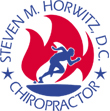 |
| Click here to access Dr. Horwitz's website, with a complete listing of classes and products. |
By Dr. Steven M. Horwitz, Maryland Director, National Strength and Conditioning Association
Welcome to my Golf Fitness Made Easy column. Each month I will write an article about golf fitness or golf injuries. These articles will have specific information that you can use immediately to improve your fitness and prevent and treat injuries. Let’s get started…
It is wintertime here in the northeast, which makes it difficult to get out on a golf course. So what can you do over the winter to improve your game? Get Fit!
The biggest trend on the PGA and LPGA tours is not just in the bag, but also in the gym. Professional golfers now realize that the best method of performance enhancement and injury prevention is to start a golf fitness program. At the beginning of his career, the one key thing that Tiger did, that no other golfer at that time did, was follow a scientifically designed, year-round strength, flexibility, and conditioning program.
In his book, The Egoscue Method of Healing In Motion, Peter Egoscue writes, "Unless golf faces up to the indifference it has traditionally shown to the body and its proper functioning, the booming interest in golf won't last. The sport will be swamped in pain. Thirty and forty-year-olds who are now heading for the fairways in droves are the least functional generation who has ever teed up a golf ball. They bring dysfunction... by playing hour after hour, day after day, and this repetitive compensation motion injures them."
When it comes to golf fitness and golf injury prevention, the most important area is the core. The golf swing starts in the feet, the legs begin to generate power, and the core directs and amplifies this controlled power. During a controlled and powerful swing, the core must be strong enough to maintain this sequential transfer of momentum between the upper and lower body. The torquing motion of the golf swing puts tremendous stress on the lower back (lumbar spine) and the core also provides support and protection to this often-injured area.
What is the core? The core is made up of the muscle groups in the front (“abs”), the sides (obliques), the back (lower back muscles), the buttocks, and the hamstrings (rear thigh). (See images below)
Before you start a core exercise program, you must learn something called abdominal bracing. This contraction of your core muscles teaches you to use all your core muscles in a synchronous manner. It is what will protect your spine and improve your game. Take a look at the pictures below:
An abdominal brace occurs when you have contracted the abdominal muscles, lower back muscles, and buttock muscles at the same time. Here is how to do it:
- Stand up straight and place one hand on the small of your back and one hand on your abdomen. Position 1
- Bend forward at the waist and feel the lower back (extensor) muscles contract. Position 2
- Come back to an upright posture and feel them “turn off.”
- Without moving, contract the abdominal muscles (like you are about the get punched in your gut - feel them tighten with your hand) and feel the lower back muscles contract (with the other hand).
- At the same time as you contract your abdominal muscles; add a contraction of the buttock muscles (as if you are holding in a bowel movement). This will supply even more stability to the spine. This is an abdominal brace – all the muscles around the torso contract to ensure stability.
- Do not hold your breath during this maneuver. You must learn to brace your abdomen without a complete holding of your breath.
Now that you know how to perform the abdominal brace you can use it when performing any of the following exercises AND when you swing a golf club. The following is your winter core program. Start with Progression #1 (See below for positions and descriptions). Your goal is to be able to perform 3 sets of 60-second holds before moving to Progression #2.
Practice these exercises daily for the next two months and you will be amazed at how much better you feel and much your swing, accuracy, and distance will improve. Enjoy!
The best equipment you can invest in is yourself!
 |
| Abdominals |
 |
| Obliques |
 |
| Lower Back Muscles |
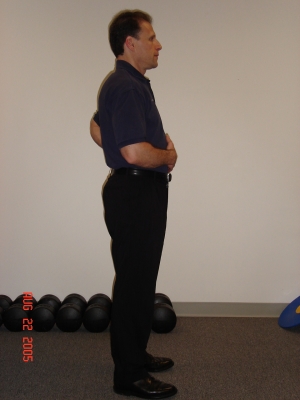 |
| Abdominal Brace -- Position 1 |
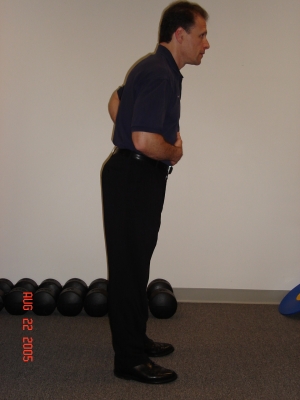 |
| Abdominal Brace -- Position 2 |
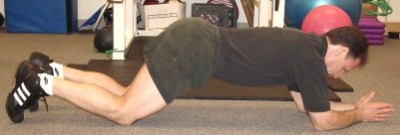 |
| Prone Plank Progression #1: Off Knees -- Elbows under shoulders, knees behind hips. Make sure your abs and glutes are tight when you hold this position. Start by holding for 15 seconds, rest for 30 seconds, and perform 3 sets. |
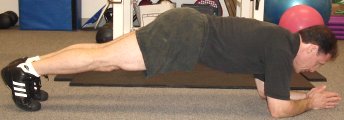 |
| Progression #2: Off Toes -- Elbows under shoulders, on toes. Make sure your abs and glutes are tight when you hold this position. Start by holding for 15 seconds, rest for 30 seconds, and perform 3 sets. |
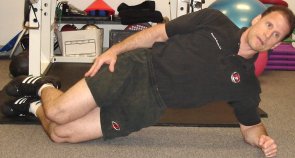 |
| Side Bridge Progression #1: Off Knees -- Lie on your side, knees bent to 90°, supported by elbow bent to 90°. Place the free hand on your opposite shoulder or leave it along your side. Keep torso straight and lift buttocks off the ground. Keep hips forward, squeeze buttocks and abs tight. Start by holding for 15 seconds, rest for 30 seconds, and perform 3 sets. |
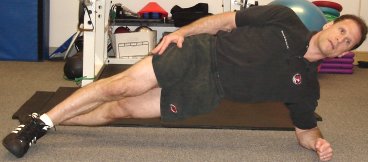 |
| Side Bridge Progression #2: Off Toes -- Lie on your side, supported by elbow bent to 90°. Same as above. Start by holding for 15 seconds, rest for 30 seconds, and perform 3 sets. |
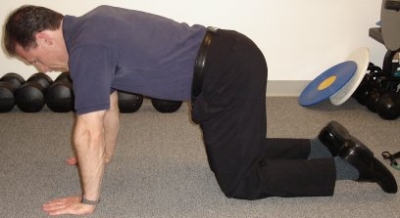 |
| All Fours -- Get on all fours, knees under hips and hands under shoulders. Squeeze your buttocks and abs. Reach forward with one arm to a horizontal position and hold for 5 seconds. Reach back with one leg to a horizontal position and hold for 5 seconds. Make your limbs "long" when your reach. Repeat with opposite arm and leg. |
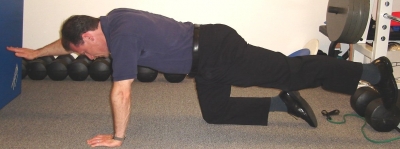 |
| Once you can reach with a single limb and keep your torso stable, reach forward with the right arm and reach back with the left leg to a horizontal position. Hold for 10 seconds, rest for 20 seconds, and perform 3 sets. |
Details:
Dr. Steven Horwitz is certified as a Chiropractic Sports Physician, Strength and Conditioning Specialist, and a USA Weightlifting Club Coach. Dr. Horwitz was selected by the United States Olympic Committee as the sole chiropractor for the 1996 United States Olympic Team and has traveled internationally with U.S.A. Track and Field. In 1996, the Governor appointed Dr. Horwitz to the Maryland Council on Physical Fitness and served as Chairman of the council from 2002 to 2004. In 2004, Dr. Horwitz was selected as the Maryland State Director for the National Strength and Conditioning Association. He is a recipient of the Maryland Chiropractic Association's Outstanding Achievement Award and Washingtonian magazine has chosen him as one of the Washington, D.C. area's top sports medicine doctors. Dr. Horwitz is the author of the book YOU CAN BE FIT! and he competes in powerlifting and bodybuilding. He is a certified ART® and Graston Technique practitioner and practices in Silver Spring, Maryland.
Steven M. Horwitz, DC, CCSP, CSCS, USAW
Maryland Director, National Strength and Conditioning Association
Chairman, Maryland Council on Physical Fitness 2002-2004
12200 Tech Road, Suite 104
Silver Spring, MD 20904
301-622-9000
www.youcanbefit.com/golffitness.html
Note: Click on the link above to learn about Dr. Horwitz's full line of fitness classes and products.
| Related Links | Comments on this article? | |
|
Maryland National Golf Club Hollow Creek Golf Club Rocky Gap Resort PB Dye Golf Club in Ijamsville Whiskey Creek Golf Club |
E-mail Jeff Rendall, Editor: jrendall@golftheunitedstates.com |











